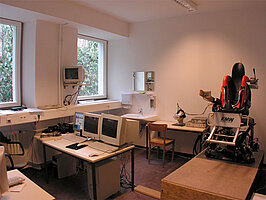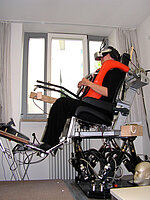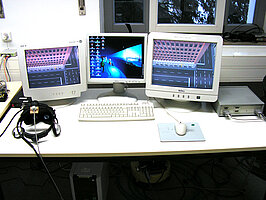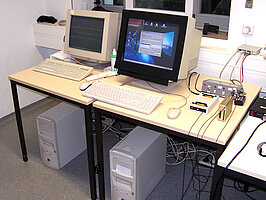VR-Labs (Prof. Dr. Paul Pauli)
Description
Virtual reality (VR) is defined as a computer-simulated world in which a user can look around, move, and react to the virtual environment. One is transported into virtual reality by stimulating visual, acoustic, vestibular and - depending on the application - tactile or nociceptive sensory channels. VR equipment allows for a certain degree of immersion, this is one of the prerequisites for creating a sense of presence in VR.
By using a head-mounted display (HMD) with tracking sensors, the viewing direction and movement of a user can be realized in real time within the 3D world. Additional input devices can be used for navigation and interactions.
Predefined events and processes can be activated manually via a control interface or automatically. Both the 3D world and the interface can be manipulated using programming scripts.
Using different inputs and outputs, VR experiences can be presented in a variety of ways: presented on a computer monitor, via mono/stereoscopic HMD, or with screen projections.
The virtual environments are used in applied and experimental research, and in the psychotherapeutic work of the University outpatient clinic for exposure therapy in anxiety disorders.
VR exposure therapy for specific phobias: fear of flying, fear of spiders, fear of heights, fear of tunnels
Read more: Outpatient center for Psychiatry
Research projects
Ongoing research projects:
- Context conditioning: Generalization, discrimination, extinction, and the influence of risk factors (2016-2020)
- Gait Rehabilitation (2017- )
- Virtual Embodiment and Pain (2017- )
- Virtual Physicians and Pain (2017- )
- From mice to men: Re-translational approaches testing the translational validity of behavioral animal paradigms (2017- )
- Fear of Pain (2020-2025)
- Influence of perceived social support in virtual reality on pain processing (2020- )
Completed research projects:
- Präsenz und Furcht in virtuellen Umgebungen - 2016
- Immersion und Furcht bei virtueller Höhenexposition - 2015
- Höhensimulation - 2008
- Untersuchung des sozialen Interaktionsverhalten - 2007
- Tunnelnotausgang - Wirkungsuntersuchung - 2006
- Flugsimulation Flughafen Nürnberg - 2006
- Höhensimulation - 2005
- Raum mit animierten Spinnen - 2004
- Etage des Uni-Würzburg Hauptgebäude am Sanderring - 2004
- Tunnelfahrt - 2003
Cybersession
With the Virtual Reality Therapy Interface "Cybersession" it is possible to use 3D simulations for exposure exercises.
The system was designed to present exposure stimuli in a controlled manner in virtual reality.
For empirical studies, it is possible to control the simulation process using Skipte and to record the data.
The system can be operated without specialized computer knowledge.
www.cybersession.info, CyberSession Wiki, CyberSession Changelog
Hardware
The technology for representing virtual worlds is largely based on commercially available computer components. Optimal display quality can be achieved with a renderer optimized for 3D graphics and control with an additional control PC / notebook.
There are a number of options for presenting VR.
For the visual presentation, a head-mounted display with the largest possible viewing angle and a closed view is recommended.
The graphics output via a projector enables the construction of highly immersive VR rooms.
The most cost-effective output option - via monitor - is possible, but only produces limited immersion.
These VR presentation methods are possible with monoscopic and stereoscopic displays.
Stereoscopic variants:
- HMD: by dual-view / display of images offset by the interpupillary distance.
- Projection: polarization filter + glasses, or anaglyph representation + glasses
- Monitor: shutter glasses, or anaglyph + glasses
- Auto-stereo 3D monitors
Laboratory equipment
- HMD
- Virtual Research HMD V6 - resolution 640x480, FOV 60° (diagonal)
- eMagin Z800, 800x600, FOV 40°
- Tracker
- Polhemus FASTRACK 6DOF * 4 sensors, standard + long-range transmitter
- Polhemus Minuteman 3DOF * 2 sensors
- Intersense InertiaCube2 Tracker 3DOF
- Arrington eye tracker
- Physiology capture
- Mobile multi-channel data recorder Vitaport
- Multi-channel amplifier Synamps
- Brainvision V-Amp
- Krauss-Maffei Wegmann movement platform
6DOF, micro-motion system 4DOF, hydraulic
- VC-M2 motion system 4DOF, pneumatic
- Input devices
- Steering wheel + pedals
- Gampad
- joystick
- Audio mixer, mikrophones
Department I maintains laboratories equipped with VR technology.










